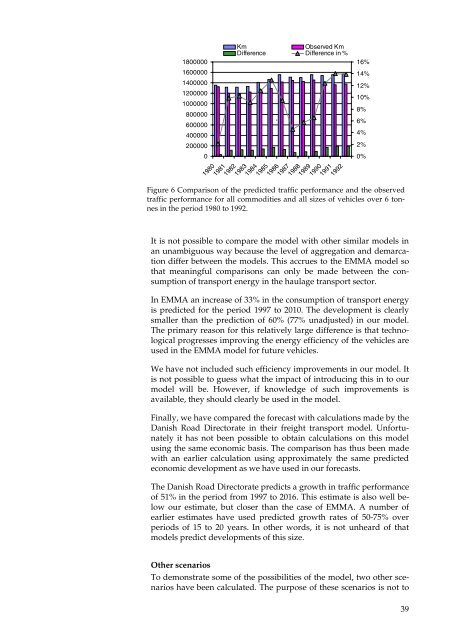En model for godstransportens udvikling - DCE - Nationalt Center for ...
En model for godstransportens udvikling - DCE - Nationalt Center for ...
En model for godstransportens udvikling - DCE - Nationalt Center for ...
You also want an ePaper? Increase the reach of your titles
YUMPU automatically turns print PDFs into web optimized ePapers that Google loves.
1800000<br />
1600000<br />
1400000<br />
1200000<br />
1000000<br />
800000<br />
600000<br />
400000<br />
200000<br />
0<br />
1980<br />
1981<br />
Km Observed Km<br />
Difference Difference in %<br />
1982<br />
1983<br />
1984<br />
1985<br />
1986<br />
1987<br />
1988<br />
1989<br />
1990<br />
1991<br />
1992<br />
Figure 6 Comparison of the predicted traffic per<strong>for</strong>mance and the observed<br />
traffic per<strong>for</strong>mance <strong>for</strong> all commodities and all sizes of vehicles over 6 tonnes<br />
in the period 1980 to 1992.<br />
,<br />
It is not possible to compare the <strong>model</strong> with other similar <strong>model</strong>s in<br />
an unambiguous way because the level of aggregation and demarcation<br />
differ between the <strong>model</strong>s. This accrues to the EMMA <strong>model</strong> so<br />
that meaningful comparisons can only be made between the consumption<br />
of transport energy in the haulage transport sector.<br />
In EMMA an increase of 33% in the consumption of transport energy<br />
is predicted <strong>for</strong> the period 1997 to 2010. The development is clearly<br />
smaller than the prediction of 60% (77% unadjusted) in our <strong>model</strong>.<br />
The primary reason <strong>for</strong> this relatively large difference is that technological<br />
progresses improving the energy efficiency of the vehicles are<br />
used in the EMMA <strong>model</strong> <strong>for</strong> future vehicles.<br />
We have not included such efficiency improvements in our <strong>model</strong>. It<br />
is not possible to guess what the impact of introducing this in to our<br />
<strong>model</strong> will be. However, if knowledge of such improvements is<br />
available, they should clearly be used in the <strong>model</strong>.<br />
Finally, we have compared the <strong>for</strong>ecast with calculations made by the<br />
Danish Road Directorate in their freight transport <strong>model</strong>. Un<strong>for</strong>tunately<br />
it has not been possible to obtain calculations on this <strong>model</strong><br />
using the same economic basis. The comparison has thus been made<br />
with an earlier calculation using approximately the same predicted<br />
economic development as we have used in our <strong>for</strong>ecasts.<br />
The Danish Road Directorate predicts a growth in traffic per<strong>for</strong>mance<br />
of 51% in the period from 1997 to 2016. This estimate is also well below<br />
our estimate, but closer than the case of EMMA. A number of<br />
earlier estimates have used predicted growth rates of 50-75% over<br />
periods of 15 to 20 years. In other words, it is not unheard of that<br />
<strong>model</strong>s predict developments of this size.<br />
Other scenarios<br />
To demonstrate some of the possibilities of the <strong>model</strong>, two other scenarios<br />
have been calculated. The purpose of these scenarios is not to<br />
16%<br />
14%<br />
12%<br />
10%<br />
8%<br />
6%<br />
4%<br />
2%<br />
0%<br />
39

















